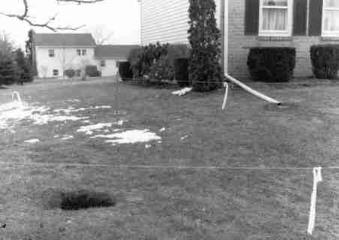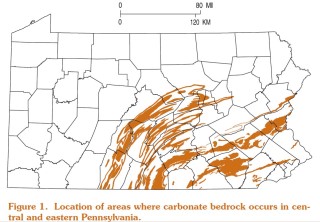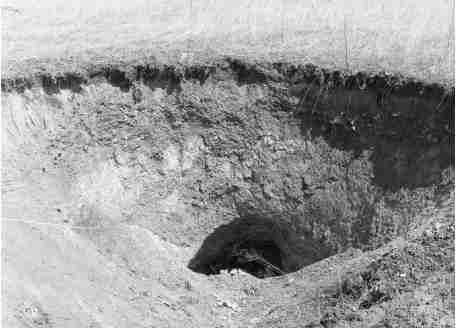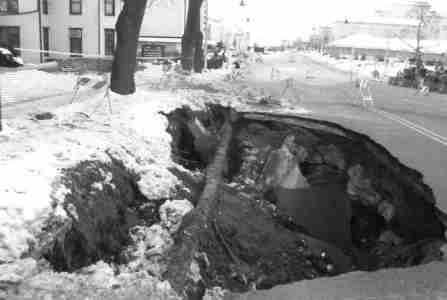 Pennsylvania Sinkholes
Pennsylvania Sinkholes
- POST a QUESTION or COMMENT about sinkholes and their effects on buildings
Sinkholes in Pennsylvania:
This article describes the location & type of sinkholes occurring in Pennsylvania and cites the PA DCNR who report that while serious sinkholes do occur in some areas of the state they do not occur state-wide.
This article series explains what sinkholes are and why they occur, describes their effects on buildings, and gives building and site inspection advice useful in identifying areas where there is an increased risk of sink holes at properties.
The photograph (above-left) of a sinkhole opening in a residential yard in Pennsylvania is from Kochanov, W.E. and illustrates the child hazard or even adult sinkhole hazard that can be formed by storm water drainage.
We provide a catalog of types of sink holes around the world including California, Canada, Quebec, Estonia, Guatemala, Maryland, New York, Pennsylvania, Texas,Tennessee, Virginia and other states and provinces and countries. Explanation of causes of sinking buildings from events other than sinkholes.
InspectAPedia tolerates no conflicts of interest. We have no relationship with advertisers, products, or services discussed at this website.
Sinkholes in Pennsylvania

Sudden subsidences and sinkholes in some areas of Pennsylvania have been associated with coal mining activities combined with surface and subsurface water drainage or pumping.
[click to enlarge any image or table]
"Sinkholes" that are not verified by a licensed professional geologist or geotechnical engineer to be a true sinkhole are also described in various publications as subsidence incidents.
Readers should see SINKHOLES - IMMEDIATE SAFETY ACTIONS, and also see FOUNDATION CRACKS & DAMAGE GUIDE and CESSPOOL SAFETY WARNINGS.
Additional septic system safety warnings are at SEPTIC & CESSPOOL SAFETY.
The bare minimum that a property owner needs to know about sinkholes or any other sudden subsidence of soils at a property is that these conditions might be very dangerous.
Someone falling into a sink hole or into a collapsing septic tank could be seriously injured or even die.
If a suspicious hole, subsidence, or depression appears at a property the owner should rope off and prevent access to the area to prevent anyone from falling into the opening, and then should seek prompt assistance from a qualified expert, geotechnical engineer, septic contractor, excavator, or the like.
De-watering Sinkholes
Sinkholes that are manmade also include subsidences caused by de-watering due to pumping and removal of subsurface water either for consumption or for drainage.
De-watering sinkholes have been widely reported including in Maryland, Pennsylvania, and Florida. - See Newton, J. G. and Sinclair, W. C..
Illustrations and portions of this text are from Kochanov, W.E.
Sinkhole Sizes in Pennsylvania
 On average, sinkholes in Pennsylvania range from 4 to 20 feet in diameter and 4 to 20 feet in depth.
On average, sinkholes in Pennsylvania range from 4 to 20 feet in diameter and 4 to 20 feet in depth.
If a sinkhole develops over an area due to mining, its size and depth may be significantly different than these "natural" sinkholes not directly related to human activity.
A sinkhole is a subsidence feature. Subsidence is the downward movement of surface material; it involves little or no horizontal movement. Subsidence occurs naturally due to the physical and chemical weathering of certain types of bedrock.
Subsidence can also occur as a result of underground mining, excessive pumping of groundwater, or subsurface erosion due to the failure of existing utility lines.
All of these examples of subsidence can produce surface features that appear similar, but not all are naturally occurring.
Some are solely the result of human activities. - Kochanov, W.E. cited below.
Where do Sinkholes Occur in Pennsylvania?
The PA DCNR illustration (above) demonstrates that in Pennsylvania sinkholes occur in certain areas, not state wide, and track principally areas where carbonate bedrock is found
. [This illustration does not track the effect of coal mining on sinkholes.]

Continuing from Kochanov,
Case histories of sinkhole occurrence reveal that sinkholes occur only in certain parts of Pennsylvania. By examining these records, we learn that sinkholes are found in areas underlain by carbonate bedrock.
Large areas of central and eastern Pennsylvania are underlain by this type of bedrock [see the figure above].
We can now add this information to the definition of a sinkhole. A sinkhole is a subsidence feature in an area underlain by carbonate bedrock. It can form rapidly and is characterized by a distinct break in the land surface and the downward.
The PA DCNR photograph of a Pennsylvania sinkhole (above) shows the throat and arch of a typical occurrence.
In Pennsylvania sinkholes formed as Kochanov describes, one side of the sinkhole is steep (the upper portion of the photo), and the other side is more gently sloped. The arch that has formed over the sinkhole's drainage throat forms the sinkhole roof.

If a sinkhole roof collapses, this structure can convert to a sudden and larger subsidence or sinkhole (as occurs in Florida and in Pennsylvania).
Depending on the initial sinkhole tunnel, throat, size, soil rock and water conditions, the result may be a shallow depression, or a larger, more catastrophic soil collapse such as shown in this second photo from Kochanov and the PA DCNR.
Multiple sinkholes close together in an area may also collapse to form a series of depressions or a single larger sinkhole or depression as this PA DCNR photo shows.
Pennsylvania Sinkhole & Subsidence Resources
- Thomas, Brigette, and Mary JS Roth. "Evaluation of site characterization methods for sinkholes in Pennsylvania and New Jersey." Engineering Geology 52, no. 1 (1999): 147-152.
Abstract:
This study addresses the question of what is the state-of-the-practice of site characterization methods for locating sinkholes or potential sinkholes in the Great Valley Section of eastern Pennsylvania and northern New Jersey. This geographic area has recently experienced the failures of a large office building and a number of residential structures.
Sixty engineering firms practicing in this area were asked to respond to a survey concerning the methods currently being employed for locating sinkholes. Twelve firms responded.
This paper provides a summary of the 12 methods used to detect voids, the percentage of firms using the different methods and a description of the reliability of each methods.
Recommendations concerning site characterization methods for the Great Valley area are also given. - Dougherty, Percy H., and Michael Perlow. "The Macungie Sinkhole, Lehigh valley Pennsylvania: Cause and repair." Environmental Geology and Water Sciences 12, no. 2 (1988): 89-98.
Abstract:
A dramatic sinkhole collapse measuring some 100 feet in diameter by 41 feet deep occurred suddenly in the Borough of Macungie on June 23, 1986. The sinkhole collapse resulted in a major disruption of traffic, utility services, as well as a major health and safety hazard.
Continual growth of the sinkhole could have resulted in almost certain damage or loss to more than 17 residences adjacent to the sinkhole collapse. Stabilization and repair costs totaled some $450,000 and required almost three months to restore utility services, roadway, and parking areas. - Dyne, Laura Anne. "The prediction and occurrence of chimney subsidence in southwestern Pennsylvania." (1998).
Abstract:
Coal mining in Pennsylvania has long been an important factor in the economic development of the commonwealth. However, the mines abandoned before today's strict environmental regulations have degraded over half of Pennsylvania's counties.
Subsidence incidents, known as chimney caves, are in the form of sinkholes and develop above abandoned room-and-pillar mines. Chimney caving is the most dominant type of subsidence in southwestern Pennsylvania, yet there are no accurate means available to predict their occurrences.
Therefore, an investigation has been conducted in order to develop a set of engineering criteria, or an equation, to predict such occurrences. Through conducting sand model experiments and through the collection of a chimney subsidence incident database, such an equation was derived, and verified using actual field data. - Foose, Richard M. "Ground-water behavior in the Hershey Valley, Pennsylvania." Geological Society of America Bulletin 64, no. 6 (1953): 623-645.
- Kochanov, W. E., 1999, SINKHOLES in PENNSYLVANIA, [PDF] Pennsylvania,
Geological Survey, 4th ser., Educational Series 11,
33 p., 3rd printing April 2005, Pennsylvania Department of Conservation and Natural Resources / Bureau of Topographic and Geologic Survey, DCNR Educational Series 11, Pennsylvania Geological Survey, Fourth Series, Harrisburg,
1999 - web search 06/05/2010, original source: http://www.dcnr.state.pa.us/topogeo/hazards/es11.pdf - Quoting from the document introduction:
The first 18 pages of this booklet contain an explanation of how sinkholes develop. In order to tell the sinkhole story, it is important to discuss a number of related geologic disciplines. The words used to describe sinkholes and these disciplines may be a bit unfamiliar.
However, general explanations are given throughout the booklet to help clarify their meanings. Key words are printed in bold type for emphasis. The more important ones are defined in a Glossary that begins on page 29.
The remaining sections, starting with “Sinkholes in the Urban Environment” (page 18), deal with sinkholes and their impact on our environment. This includes recognition of subsidence features and sinkhole repair. - Myers Jr, P. B., and M. Perlow Jr. "Development, occurrence, and triggering mechanisms of sinkholes in the carbonate rocks of the Lehigh Valley, eastern Pennsylvania." In Multidisciplinary conference on sinkholes. 1, pp. 111-115. 1984.
- Detecting Sinkholes with Geophysics, Enviroscan, Inc., Lancaster PA 717-396-8922 email@enviroscan.com www.enviroscan.com 2003
- White, Elizabeth L., Gert Aron, and William B. White. "The influence of urbanization of sinkhole development in central Pennsylvania." Environmental Geology 8, no. 1 (1986): 91-97.
Abstract:
The karsted limestone valleys of central Pennsylvania contain two populations of sinkholes. Solution sinkholes occur in the Champlainian limestone units along the margins of the valleys. Solution sinkholes are permanent parts of the landscape and, although a nuisance to construction, do not present other problems.
The second population is the suffosional or soil-piping sinkholes These occur on all carbonate rock units including the Beekmantown and Gatesburg dolomites that comprise the two principal carbonate aquifers in the valley. Suffosional sinkholes are the principal land-use hazard.
Suffosional sinkholes are transient phonomena. They occur naturally but are exacerbated by runoff modifications that accompany urbanization Suffosional sinkholes are typically 1.5–2.5 m in diameter depending on soil thickness and soil type.
The vertical transport of soil to form the void space and soil arch that are the precursors to sinkhole collapse is through solutionally widened fractures and cross-joints and less often through large vertical openings in the bedrock.
The limited solution development on the dolomite bedrock combined with soil thickness, seldom greater than 2 m, limits the size of the sinkholes. All aspects of suffosional sinkhole development are shallow processes: transport, piping, void and arch formation, and subsequent collapse take place usually less than 10 m below the land surface
Factors exacerbating sinkhole development include pavement, street, and roof runoff which accelerates soil transport Such seemingly minor activities as replacing high grass and brush with mowed grass is observed to accelerate sinkhole development. Dewatering of the aquifer is not a major factor in this region - Wilshusen, John P. Geologic hazards in Pennsylvania. Vol. 9. Commonwealth of Pennsylvania, Department of Environmental Resources, Bureau of Topographic and Geologic Survey, 1979.
...
Continue reading at SINKHOLE DAMAGE REPAIRS or select a topic from the closely-related articles below, or see the complete ARTICLE INDEX.
Or see these
Sinkhole & Subsidence Articles
Suggested citation for this web page
SINKHOLES in PENNSYLVANIA at InspectApedia.com - online encyclopedia of building & environmental inspection, testing, diagnosis, repair, & problem prevention advice.
Or see this
INDEX to RELATED ARTICLES: ARTICLE INDEX to SINKHOLES
Or use the SEARCH BOX found below to Ask a Question or Search InspectApedia
Ask a Question or Search InspectApedia
Questions & answers or comments about sinkholes and their effects on buildings.
Try the search box just below, or if you prefer, post a question or comment in the Comments box below and we will respond promptly.
Search the InspectApedia website
Note: appearance of your Comment below may be delayed: if your comment contains an image, photograph, web link, or text that looks to the software as if it might be a web link, your posting will appear after it has been approved by a moderator. Apologies for the delay.
Only one image can be added per comment but you can post as many comments, and therefore images, as you like.
You will not receive a notification when a response to your question has been posted.
Please bookmark this page to make it easy for you to check back for our response.
Our Comment Box is provided by Countable Web Productions countable.ca
Citations & References
In addition to any citations in the article above, a full list is available on request.
- Florea, Lee J. "Using State-wide GIS data to identify the coincidence betwen sinkholes and geologic structure." Journal of Cave and Karst Studies 67, no. 2 (2005): 120-124.
- Waltham, Tony, Frederic Gladstone Bell, and M. G. Culshaw, Sinkholes and subsidence, Springer/Praxis, 2005.
- Avongard FOUNDATION CRACK PROGRESS CHART [PDF] - structural crack monitoring
- Building Pathology, Deterioration, Diagnostics, and Intervention, Samuel Y. Harris, P.E., AIA, Esq., ISBN 0-471-33172-4, John Wiley & Sons, 2001 [General building science-DF] ISBN-10: 0471331724 ISBN-13: 978-0471331728
- Building Pathology: Principles and Practice, David Watt, Wiley-Blackwell; 2 edition (March 7, 2008) ISBN-10: 1405161035 ISBN-13: 978-1405161039
- Diagnosing & Repairing House Structure Problems, Edgar O. Seaquist, McGraw Hill, 1980 ISBN 0-07-056013-7 (obsolete, incomplete, missing most diagnosis steps, but very good reading; out of print but used copies are available at Amazon.com, and reprints are available from some inspection tool suppliers). Ed Seaquist was among the first speakers invited to a series of educational conferences organized by D Friedman for ASHI, the American Society of Home Inspectors, where the topic of inspecting the in-service condition of building structures was first addressed.
- Building Failures, Diagnosis & Avoidance, 2d Ed., W.H. Ransom, E.& F. Spon, New York, 1987 ISBN 0-419-14270-3
- "A Foundation for Unstable Soils," Harris Hyman, P.E., Journal of Light Construction, May 1995
- "Inspecting Block Foundations," Donald V. Cohen, P.E., ASHI Reporter, December 1998. This article in turn cites the Fine Homebuilding article noted below.
- "When Block Foundations go Bad," Fine Homebuilding, June/July 1998
- In addition to citations & references found in this article, see the research citations given at the end of the related articles found at our suggested
CONTINUE READING or RECOMMENDED ARTICLES.
- Carson, Dunlop & Associates Ltd., 120 Carlton Street Suite 407, Toronto ON M5A 4K2. Tel: (416) 964-9415 1-800-268-7070 Email: info@carsondunlop.com. Alan Carson is a past president of ASHI, the American Society of Home Inspectors.
Thanks to Alan Carson and Bob Dunlop, for permission for InspectAPedia to use text excerpts from The HOME REFERENCE BOOK - the Encyclopedia of Homes and to use illustrations from The ILLUSTRATED HOME .
Carson Dunlop Associates provides extensive home inspection education and report writing material. In gratitude we provide links to tsome Carson Dunlop Associates products and services.

